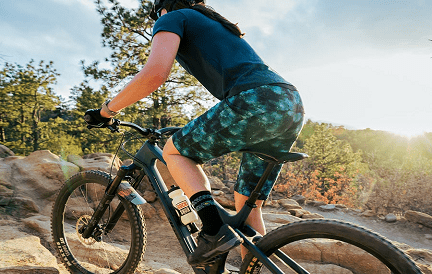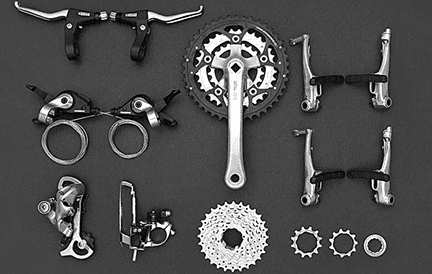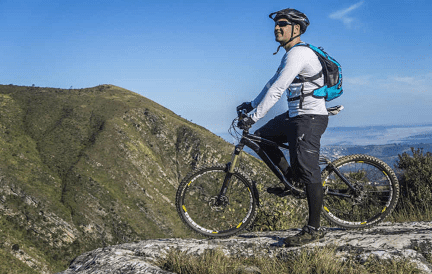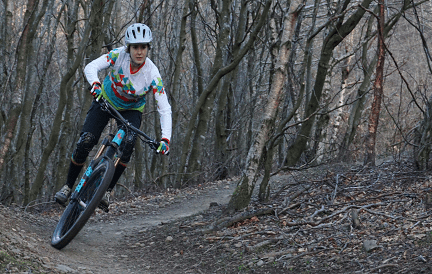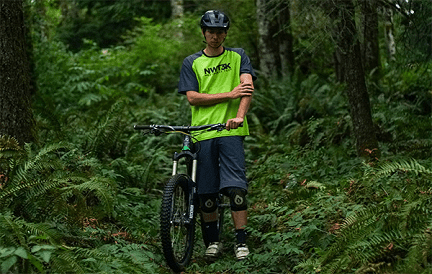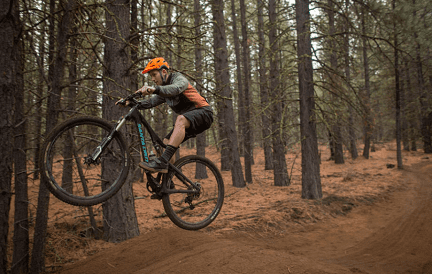Downhill jerseys are short-sleeved or long-sleeved models which you can adjust according to the weather and your preferences. The downhill jersey has a slightly wider cut so that you can fit special protectors underneath.
- Part 1: Dress to DH
- Part 2: Buying Guiline for Downhill Jersey
- Part 3: What is Different Between Bike Clothing
- Part 4: Other Apparels for DH
- Part 5: FAQ
Part 1: Dress to DH
Although the DH mountain bike jersey has a much looser fit, it is not worth buying them blind or going for an oversize style. Manufacturers know exactly how much freedom of movement a shirt should offer without too much fabric getting in the way.
Indispensable downhill jersey is not only a way to protect the body from overheating or undercooling. It is also a way to express your passion and individual character. Therefore, just after clothes’ quality, an equally important issue is their designs and prints. Often the criterion for choice becomes the favorite color, or even the color of the bike, to which we want to match the rest of the outfit.
Downhill jerseys will appeal to every two-wheeler lover because they show their fascination for cycling in an original way, and at the same time, they look impeccable on the body. You can choose from a wide variety of colors and slogans, from which every fan of this sport will find something special for themselves.
They can be matched with various shorts and shoes and are very practical and versatile. Both fans of classic, safe colors and those who like their ideas a little more crazy will find their jersey downhill. The downhill mountain bike jerseys suit people with a sense of humor and a healthy distance to themselves. The slogans on the jerseys are usually humorous, catchy, and eye-catching.
Part 2: Buying Guiline for Downhill Jersey
In a downhill Mtb jersey, you just have to feel good! This is the first and primary rule. What fits well on riders at the front of the peloton will not always look optimal on everyone else. It is crucial to choose a suitable size DH Mtb jersey that must not be too tight, but also must not flap like a flag in the wind. If you decide on a model with a welt at the bottom and on the sleeves, it is necessary to check whether the elastic band is not too tight. As it will be very uncomfortable during a long ride.
It is worth paying attention to the technologies used in a downhill jersey. They are especially important for professional cyclists. In modern jersey models, you can find, among others, a UPF filter, which protects the skin against the harmful effects of sunlight, as well as a DWR layer ensuring water resistance. In addition, the jersey must be properly cut and sized to fit the user. You can find women’s, men’s, and children’s cycling jerseys at any store. Choose such a size that the material touches your body, but does not restrict movement. Too loose jerseys are not a good choice.
Material
Technical materials from which cycling clothes are made are characterized by high quality and excellent parameters. Pay attention to how many types of fabric the jersey is sewn from. If you’re choosing a tight-fitting model, check how many directions the fabric stretches. More flexible material will improve your freedom of movement. Advanced models, for example, use flatlock seams and laser-cut sleeves. Additional ventilation panels in strategic places are definitely in favor of a given product. It’s essential that the fabric feels lovely against the skin and the whole construction is lightweight and comfortable.
Radeship Waterwear for Bike
Downhill Mtb jersey is beneficial not only for autumn and winter cycling trips. Also, in summer, the weather can be surprising and can bring rain or thunderstorm while riding. It is worth having a light cycling jacket to protect you from rain. In addition to the coat, it is also worth equipping yourself with rainproof bicycle pants. Clothes for rainy weather should be made of waterproof material.
Compressive Clothing
Regenerate your muscles with compression clothing. These specially designed compression garments help reduce muscle soreness after an intense ride. The bands and socks available in this category will facilitate blood circulation and speed up the recovery of your legs before or after a workout.
Zip And Pockets
If you usually ride with a backpack or have panniers or a basket for transport, pockets in a cycling jersey are unnecessary. However, they will be a great solution during training or competitions if you do not plan to take your backpack with you. They can accommodate a handy pump and spare tube, energy bar or gel, money, ID, keys, or smartphone. The pocket in the cycling jersey will also accommodate a compact windbreaker or an extra drink bottle on sweltering days.
Over the head, with a short zip or maybe fully zipped? Usually, downhill jerseys for gravity and recreational mountain biking are as simple as possible, which means they do not have a zipper under the neck or pockets on the back. They should be maximally light and airy. On the other hand, on the road and in XC, it is the perfect fit that counts. That is why the zipper is indispensable to wear a flexible cycling suit. A long, full zip is also a practical option on hot days – thanks to a larger jersey opening, you can regulate the body temperature.
Selection Based on Season
Sunshine and favorable temperatures are almost ideal for cycling. However, there are months when the thermometers show even 30 degrees during the day. But you don’t want to give up a planned trip because of that. So how to dress for cycling in summer?
Cycling T-shirt – you should ensure that the summer downhill Mtb jersey is sewn from a breathable material, which provides air ventilation during the ride and wicks away moisture. A regular cotton T-shirt will not work well when riding in high temperatures.
Short cycling pants are another obligatory item in a cyclist’s closet. Similarly, as in the case of jerseys, the material of cycling shorts should be sweat-wicking and well ventilate the lower part of the body. This will prevent the occurrence of painful burns.
When cycling in winter, it is advisable to dress in the so-called onion style. Put on a few thin layers of cycling clothes to protect you from the cold. When it gets a bit warmer, you can take off one of your layers and regulate your body temperature. What else should you equip yourself with for winter riding? The basics are, of course, a cycling jersey and warm socks.

Part 3: What is Different Between Bike Clothing
Matching Your Riding Style
Downhill mountain bike jerseys should also be tailored to the type of cycling. This is because the jersey will look different for an MTB rider tackling steep descents and a rider who is speeding his road bike on paved trails. What are the main differences?
Professional Downhill Clothing
Fitted to the cyclist’s body shape to reduce drag while riding. Cycling jerseys and shorts adhere to the body while allowing freedom of movement. The jerseys feature a zipper for easy on and off the tight outfit. Additional functionality includes zippered pockets located on the front or back of the jersey.
MTB Cycling Clothing,
Also, trail or enduro riding is a clothing model distinguished by a broader and looser cut. This makes it easier to comfortably climb challenging hills or perform complex riding maneuvers. MTB shirts usually have no pockets because cyclists take generally a rucksack with them on longer trips.
Part 4: Other Apparels for DH
- Sweatshirt or cycling jacket
An additional layer of clothing should be put on over your cycling jersey. It will protect you from wind and cold during the ride and protect your body from heat loss. - Long bike pants
It is worth equipping up yourself with warmer bike pants with long for colder months. When cycling in negative temperatures, it is essential to protect your joints against cold. - Bicycle gloves
You should also protect your hands in winter. Full gloves will keep your fingers warm, prevent frostbite and make it easier to grip the handlebars. - Cycling headgear
A helmet obviously comes to mind when we talk about cycling headgear. However, we need to remember that it is not the only element of a cyclist’s outfit that we wear while riding. It is worth thinking about head protection against cold in the form of scarves or caps under the helmet.
Part 5: FAQ
Downhill is a demanding sport that requires the right equipment, clothing, and protection. You will need a full-face helmet, goggles, knee, and elbow pads, armor, a buffer, and DH Mtb jersey for safety. Bike control and comfort will be better with good cycling shoes and gloves.
What Is the Point of a Mountain Bike Jersey
Tight fit, can be a bit looser than jerseys for city, road, enduro bikes. Efficiently wicks sweat. Even for more extreme gravity style riding the fit can be made even more flexible with longer sleeves providing extra protection from injury from bushes and branches.
What Should I Wear When Downhill Mountain Biking
The typical cyclist wears a DH/freeride bike jersey and shorts. You might want to think about wearing them, but consider sporty clothing (not cotton, lightweight material) that is comfortable and fits any type of riding you will be doing. Long sleeve jerseys that protect against scratches and short sleeves to cool down on hot days
Is Downhill Biking Hard
It is often thought that this is the more accessible discipline of mountain biking (because gravity can do most of the work). This is far from the truth. Proper downhill riding requires excellent skills. Don’t be fooled by the pros who make downhill riding look effortless, but first and foremost you need to be mindful of buying downhill jerseys and other clothing to protect your body from injury.
How to Protect Your Eyes While Riding
Bicycle goggles are a must-have when downhill riding and are a great addition to your head protection. It will protect your eyes from branches, sand, rocks from under the wheels of another cyclist and eliminate the need to pull out the nth fly with dirty hands. Remember to match your goggles to your helmet.
What Full-face Helmet for Downhill Should I Choose
We start from the top, that is, from the head itself. In this case, a full-face bike helmet will work best. It will protect the whole head together with the jaw, so in case of any collision or fall, it will allow minimizing or altogether avoid damage to this part of the body. Remember also that helmet is not the same as a helmet. Let’s choose unique bike models, light and ventilated. It is worth choosing those equipped with the revolutionary MIPS system, considered to be one of the safest solutions, which significantly reduces the occurrence of injuries.
What Is Armour
Extreme riding requires thorough preparation and sound equipment. It is necessary to take care not only of head and face protection but also of the torso. Another essential piece of equipment for every downhill enthusiast should be armor or a bicycle buff. A well-chosen one will protect the back, chest, critical organs, and, most importantly, the spine. What is more, if we choose a buffer of one of the top brands such as Fox, thanks to lowered collar profile, we will be able to adjust the neck stabilizer, which guarantees maximum, complete protection from the top of the head to the waist.
What Are the Ideal Shoes for Downhill
Whether you choose a platform or clipless pedals, the right shoes will give you better bike control. Better control will translate into better control and a more enjoyable ride. While both pedals were enduro type, downhill is platforms with sharp spikes that bite into the sole, providing a better grip for the shoe. When choosing shoes for downhill, keep this in mind. Spikes damage the exclusive, so the sole must be extremely solid.


